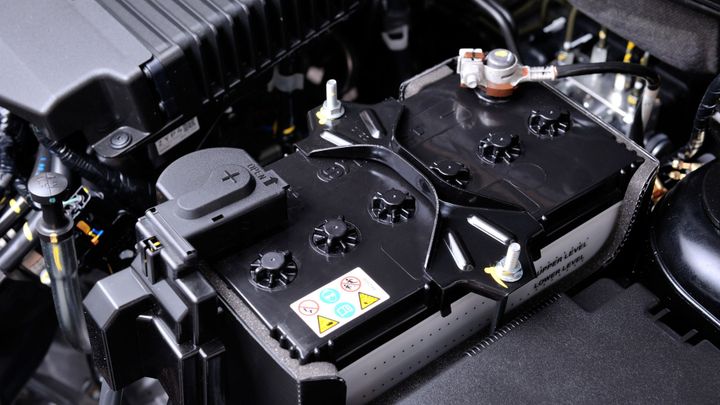


The "Battery Saver Active" warning message is a common alert that many vehicle owners encounter. This message indicates that the vehicle's electrical system has detected a potential issue with the battery or charging system. Understanding this warning is crucial for maintaining vehicle performance and preventing unexpected breakdowns.

Before we delve into the nitty-gritty of diagnosing and fixing the issue, let's first understand what this warning actually means. The "Battery Saver Active" message is your vehicle's way of telling you that there's a problem with the charging system, and it's trying to conserve the remaining battery power to prevent it from draining completely.
Think of it like a distress signal from your car's electrical system, alerting you that something isn't quite right. It's a protective measure designed to keep your battery from dying entirely, but it also means that your car won't start until the underlying issue is resolved.
Over the years, I've encountered a few common culprits that can trigger the "Battery Saver Active" warning. Let's take a closer look at these usual suspects:
| Cause | Description |
|---|---|
| Weak or Faulty Battery | If the battery is old or damaged, it may not hold a charge properly, causing the voltage to drop below the required level (usually below 12.4V). This triggers the "Battery Saver Active" mode to conserve the remaining charge and prevent the battery from draining completely. |
| Alternator Issues | The alternator is responsible for charging the battery while the engine is running. If the alternator is faulty or not charging correctly (e.g., due to a bad voltage regulator or worn belt), the battery will not be recharged, leading to a voltage drop and activating the battery saver mode. |
| Battery Cable and Connection Problems | Loose, corroded, or damaged battery cables and connections can disrupt the flow of electricity from the alternator to the battery, preventing proper charging. This can also be caused by a faulty battery current sensor, which monitors the charging system and triggers the battery saver mode if it detects an issue. |
| Electrical System Issues | Problems with other electrical components or wiring in the vehicle's charging system can also lead to charging issues and activate the battery saver mode. |
Now that we've identified the potential culprits, it's time to roll up our sleeves and get to work. As a mechanic, I follow a systematic approach to troubleshooting and diagnosing the "Battery Saver Active" issue. Here's how I tackle it:
The first step is to check the battery voltage using a trusty multimeter. With the engine off, the voltage should be above 12.4V. If it's lower, that's a clear indication that the battery needs attention. Next, I'll start the engine and check the voltage again. If it's still low (usually below 13.5V), it's a strong sign that the alternator or charging system is the root cause.
A visual inspection of the battery cables and connections can often reveal the source of the problem. I'll look for any signs of corrosion, looseness, or damage that could be disrupting the flow of electricity. If I find any issues, I'll clean or replace the problematic components to restore proper connectivity.
If the battery voltage checks out but the "Battery Saver Active" warning persists, it's time to put the alternator under the microscope. With the engine running, I'll use my multimeter to check the alternator's output voltage. If it's not within the expected range (usually around 13.5-14.5V), it's a clear sign that the alternator needs to be replaced.
Modern vehicles are equipped with sophisticated diagnostic systems that can provide valuable clues about the root cause of the issue. Using an OBD-II scanner, I'll check for any trouble codes related to the charging system or battery. These codes can help pinpoint the problem and guide my repair efforts.
Once I've identified the culprit behind the "Battery Saver Active" warning, it's time to roll up my sleeves and get to work on the repair. Here are the typical steps I follow:
| Repair | Description |
|---|---|
| Replace the Battery | If the battery is the root cause, replacing it with a new one is often the most straightforward solution. I'll ensure proper installation and connections to ensure the new battery can function optimally. |
| Replace the Alternator | If the alternator is the culprit, I'll replace it with a new or rebuilt unit. I'll also check and replace the alternator belt if necessary, as a worn or slipping belt can contribute to charging issues. |
| Replace Battery Cables and Clean Connections | In cases where the battery cables or connections are the problem, I'll replace any damaged or corroded cables and thoroughly clean the battery terminals and cable connections using a wire brush or baking soda solution. |
| Replace the Battery Current Sensor | Some vehicles are equipped with a battery current sensor that monitors the charging system. If this sensor is faulty, it can trigger the "Battery Saver Active" warning, even if the other components are functioning correctly. In such cases, replacing the sensor is necessary. |
| Check and Repair Electrical System Components | If the issue persists after addressing the common culprits, further diagnosis and repair of other electrical system components, such as wiring, fuses, or relays, may be required. This can be a more complex and time-consuming process, but it's essential to ensure the problem is resolved completely. |
As the saying goes, "an ounce of prevention is worth a pound of cure." To prevent the "Battery Saver Active" issue from recurring, I always recommend following these maintenance practices:

Regular Battery Inspection and Replacement
Batteries have a finite lifespan, so it's crucial to inspect them periodically and replace them every 3-5 years or as recommended by the manufacturer. This simple step can save you from the headache of a dead battery and the associated "Battery Saver Active" warning.
Alternator Belt Inspection and Replacement
A worn or slipping alternator belt can lead to charging issues and, ultimately, the dreaded warning. I always advise my customers to have their alternator belt inspected and replaced as per the manufacturer's recommended schedule.
Proper Battery Cable Maintenance
Keeping the battery cable connections clean and tight is essential for ensuring proper electrical flow. I recommend applying dielectric grease or an anti-corrosion spray to prevent corrosion and maintain optimal connectivity.
Avoid Excessive Electrical Loads
While it's tempting to crank up the tunes or blast the air conditioning, excessive electrical loads can drain the battery faster than the alternator can recharge it. To prevent unnecessary strain on the charging system, I advise minimizing the use of electrical accessories when the engine is not running.
Now, let's address the elephant in the room: the cost of repairs. The truth is, the cost can vary significantly depending on the specific issue and the make and model of your vehicle. However, here are some approximate cost estimates to give you an idea:
| Repair | Approximate Cost |
|---|---|
| Battery Replacement | $100 - $300 (including labor) |
| Alternator Replacement | $300 - $800 (including labor) |
| Battery Cable Replacement | $50 - $200 (including labor) |
| Battery Current Sensor Replacement | $50 - $150 (including labor and part) |
While these costs may seem daunting, it's important to remember that ignoring the "Battery Saver Active" warning can lead to more severe and costly issues down the line. That's why I always recommend having a professional mechanic diagnose and repair the problem promptly to prevent further damage and ensure your vehicle's longevity.
In some cases, the "Battery Saver Active" warning may be accompanied by other symptoms or issues that can provide additional clues about the root cause. Here are some additional considerations:
Engine Cranking but Not Starting
If the engine cranks but doesn't start, it could indicate a problem with the fuel system, ignition system, or other components that are not directly related to the charging system.
Dimming Lights or Electrical Issues
If you notice dimming lights or other electrical issues when the engine is running, it could be a sign of a faulty alternator or a problem with the wiring or electrical system.
Recent Battery Replacement
If you've recently replaced the battery and the "Battery Saver Active" warning appears, it could be due to a faulty battery or an issue with the charging system that wasn't properly addressed during the replacement.
Vehicle Age and Mileage
Older vehicles or those with high mileage may be more prone to charging system issues due to wear and tear on components like the alternator, battery, and wiring.
It's important to consider these additional factors when troubleshooting the "Battery Saver Active" warning, as they can provide valuable insights and help narrow down the root cause more effectively.
The "Battery Saver Active" warning can be a frustrating and perplexing issue, but with the right knowledge and approach, it's a problem that can be tackled head-on. As a mechanic, I've seen countless cases where a simple battery replacement or alternator repair has resolved the issue, allowing my customers to hit the road with peace of mind.
Remember, preventive maintenance is key to avoiding these types of issues altogether. By following the recommended maintenance schedules and keeping an eye on your vehicle's charging system, you can minimize the chances of encountering the dreaded "Battery Saver Active" warning.
So, the next time you find yourself staring at that ominous message on your dashboard, don't panic. Take a deep breath, and remember that with the right diagnosis and repair, your trusty ride will be back in top shape in no time. And if you ever find yourself in need of a skilled mechanic to tackle the job, you know where to find me – ready and willing to get you back on the road with a smile.
Pull over safely as soon as possible and turn off any unnecessary electrical loads. Contact a mechanic or roadside assistance for further guidance.
Yes, a faulty alternator that is not charging the battery correctly can lead to a voltage drop and trigger the "Battery Saver Active" warning.
Most mechanics recommend replacing the battery every 3-5 years or as recommended by the manufacturer to prevent issues like the "Battery Saver Active" warning.
Yes, in modern vehicles with complex electronic systems, a software glitch or update could potentially trigger the "Battery Saver Active" warning, even if the hardware components are functioning correctly.
No, it is not recommended to continue driving with the "Battery Saver Active" warning, as it indicates a problem with the charging system, which could lead to a dead battery and potential safety issues.
Yes, the "Battery Saver Active" warning could potentially impact the functionality of ADAS features, as they rely heavily on the vehicle's electrical system and may not operate correctly if the battery voltage is low.
If the warning persists after replacing the battery, it could indicate an issue with the alternator, wiring, or other components of the charging system, and further diagnosis by a mechanic is recommended.
Yes, extreme hot or cold temperatures can impact the battery's performance and potentially cause voltage fluctuations that could trigger the "Battery Saver Active" warning.
It is generally recommended to inspect and, if necessary, replace the battery cables when replacing the battery, as corroded or damaged cables can disrupt the flow of electricity and contribute to charging system issues.
Yes, a loose or corroded battery terminal can disrupt the electrical connection and prevent the battery from charging properly, potentially leading to the "Battery Saver Active" warning.

Sarah isn't your average gearhead. With a double major in Mechanical Engineering and Automotive Technology, she dived straight into the world of car repair. After 15 years of turning wrenches at dealerships and independent shops, Sarah joined MICDOT to share her expertise and passion for making cars run like new. Her in-depth knowledge and knack for explaining complex issues in simple terms make her a valuable asset to our team.













